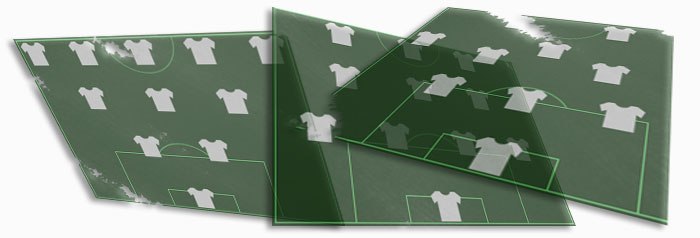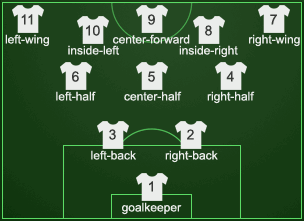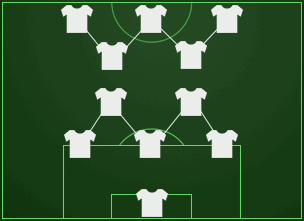All Formations and systems in football
The core of football tactics is the formation of the team. In football (soccer) the formations are classified in names consisting of numbers that represent defenders, midfielders and attackers (the goalkeeper is unnecessary to involve in this tactical aspect). Here are some of the most utilized formations in football presented in a historical overview.

Formations are simplified ways to describe a team’s positional tactic schematically. As Jonathan Wilson writes in Inverting the Pyramid: "designations of formations can at times seem a little arbitrary. Just how far behind the main striker does the second striker have to play for 4–4–2 to become 4–4–1–1? And how advanced do the wide midfielders have to be for that to become a 4–2–3–1?"
1-1-8
You probably never guess the existence of this formation in serious circumstances. It was a while ago, though, more exactly in the 19th century in the pre-modern era of football.
To use only one defense player and one midfielder and put the rest on attack seems crazy today, but the matches looked different at the current time with minimal passing in sideways and instead full attack with much dribbling going on.
To use only one defense player and one midfielder and put the rest on attack seems crazy today, but the matches looked different at the current time with minimal passing in sideways and instead full attack with much dribbling going on.
The reason for all that dribbling was not just because football in these days lacked sophistication, but more due to the fact that the offside rule was completely different from what it is today. Until 1925, the rules prescribed that a player was not allowed to be ahead of the ball (in some respects more similar to ice hockey than modern football), and as a result had to dribble it forwards.
2-3-5
In the 1890s, 2-3-5 ("the pyramid") became popular as a more balanced tactical formation. It would become standard for a long time and was used by all the British teams. The transition from 1-1-8 to 2-3-5 did not happen over a day, though. Other formations, such as 2-2-6 and 1-2-7, had been taken into practice in between.
With the popularity of the set-up, a standardization followed with numbers linked to the position on the field:

The introduction of the offside rule in 1925 started a development of other formation more adapted to the offside.
With the popularity of the set-up, a standardization followed with numbers linked to the position on the field:

The introduction of the offside rule in 1925 started a development of other formation more adapted to the offside.
W-M
One of the first side steps from the well-established 2-3-5 was the "W-M" (the attacking cluster is W-formated and the defending cluster is M-formated), or 3-2-2-3. The innovator was the great football theoretician Graham Chapman during his time as manager for Arsenal in the early 1930s.

It was a formation used by many teams in 1950 World Cup, although not by the winning team Uruguay.

It was a formation used by many teams in 1950 World Cup, although not by the winning team Uruguay.
3-2-5
After the change of the offside rule in 1925, both attacking and defending strategies would transform and new playing systems as a result emerged. The altered offside rule would benefit the attacking side so a third defender was more often taken into consideration (another formation used at this period was 3-4-4), but it was obviously still with an emphasis on attack.
Ahead of the three defenders and two midfielders there was a five-man offense. The offense was organized with one center forward flanked by double wings on both sides. Among the most successful team with this formation was Arsenal.
Ahead of the three defenders and two midfielders there was a five-man offense. The offense was organized with one center forward flanked by double wings on both sides. Among the most successful team with this formation was Arsenal.
2-3-2-3
Instead of the usual defender-midfielder-forward configuration, the so-called Metodo system brought a formation with four units into practice. This formation was used by Italy and helped the team to win the 1934 and 1938 World Cups.
Source: Footballhistory
Comments
Post a Comment